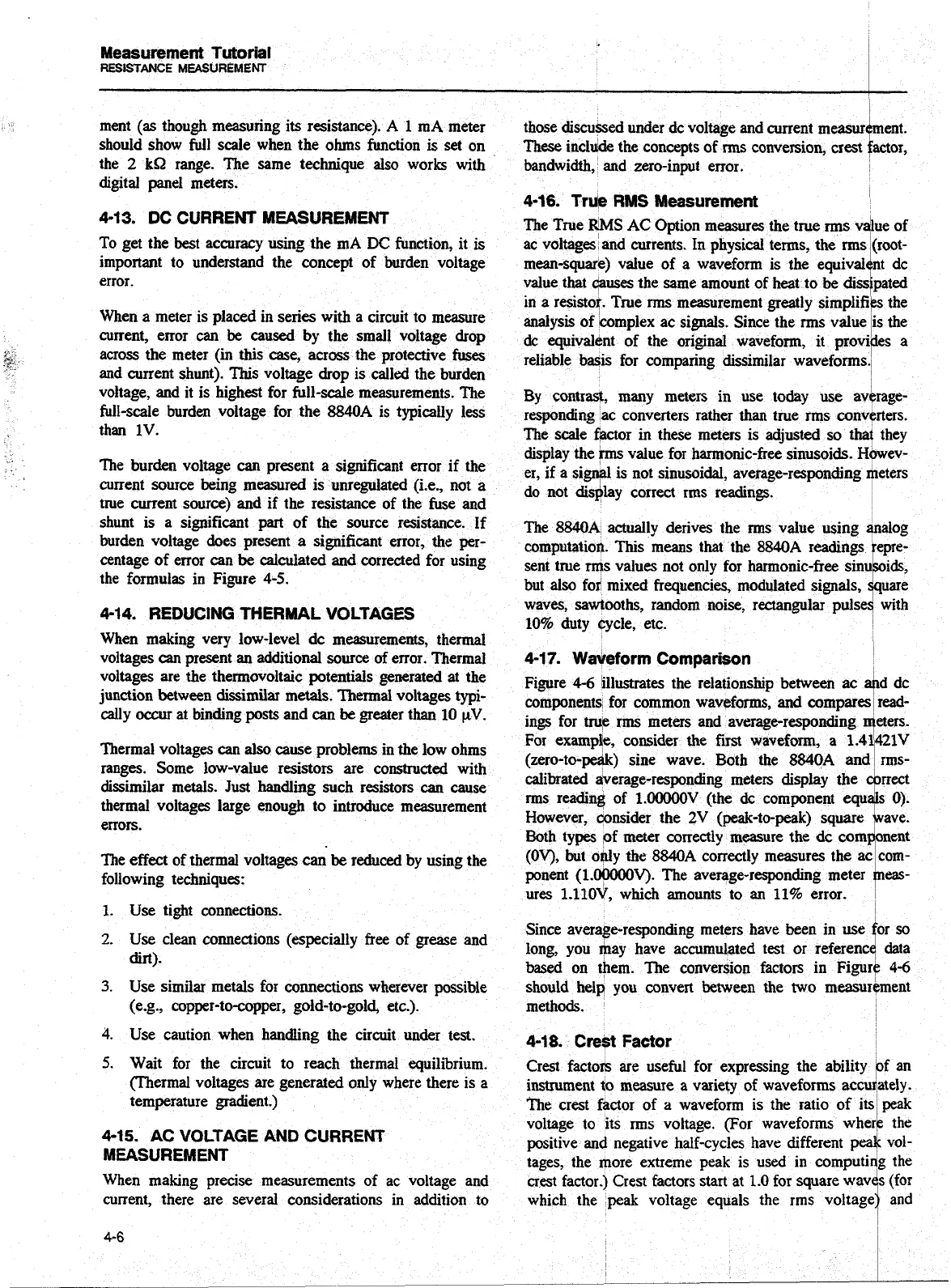Measurement Tutorial
I
RESISTANCE
MEASUREMENT
ment
(as
though measuring its resistance).
A
1
mA meter
those discussed under dc voltage and current measur
should show full scale when the ohms function is set on
These
include the concepts of
rms
conversion, crest
the
2
kS2
range. The same technique also works with
bandwidth, and zero-input error.
digital panel meters.
4-16.
Tr*
RMS
Measurement
I
4-13.
DC
CURRENT MEASUREMENT
The True
VS
AC
Option measures the true rms due of
To get the best accuracy using the mA DC function, it is
ac voltages and currents.
In
physical terms,
the
imponant to understand the concept of burden voltage
mean-square) value of a waveform is the
error.
value that
dauses
the same amount of heat
in a resistot. True
rms
measurement greatly simplifib the
When a meter is placed in series with a circuit to measure
adysk of
ac sims, since the rms
v&
is the
current, error can
be
caused by the small voltage drop
dc
equivalent of the original waveform,
it
provi es a
and current shunt). This voltage drop is called the burden
P
across the meter
(in
this case, across the protective
f~es
reliable basis for camparing dissimilar wavef~ms.~
I
voltage, and it is highest for full-scale measurements. The
BY
contrast, many meters in use today av rage-
fullscale burden voltage for the
@340A
is t~~icall~ less
responding ac converters rather
than
true rms conv rters.
than
1v.
The scale fpctor in these meters is adiusted so tha
i
they
display the
rms
value for harmonic-& sinusoids. ~bev-
burden voltage
can
Prmt a siaficant error if the
er, if a siw is not sinusoiu, a~enge-~esponding meters
went source being measured is unregulated (i.e., not a
do
not
dis+hy
corrct
rms
rradings.
I
true current source) and if the resistance of the
fuse
and
1
shunt is a signifi&nt
part
of the source resistance. If
burden voltage does present a significant error, the per-
centage of error can
be
calculated and corrected for using
the formulas in Figure
4-5.
4-14. REDUCING THERMAL VOLTAGES
When making very low-level dc measurements, thermal
voltages
can
present
an
additional source of error. Thermal
voltages are the thennovoltaic potentials generated
at
the
junction between dissimilar
metals.
Thermal voltages
typi-
cally
occur
at binding posts and
can
be
greater than 10
pV.
The
8840A
actually derives the rms value using
computation. This means that the
sent true rms values not only for harmonic-free
but also for mixed frequencies, modulated
10% duty bycle, etc.
waves,
sawtooths,
random noise,
I
4-1
7.
Waveform Comparison
Figure
4-6
illustrates the relationship between
ac
a#d dc
components for common waveforms, and compares read-
ings for trqe rms meters and average-responding qeters.
Thermal voltages
can
also
cause problems in the low ohms
ranges. Some low-value resistors are constructed with
dissimilar metals. Just handling such resistors
can
cause
thermal voltages large enough to introduce measurement
errors.
The
effect
of thermal voltages can be
reduced
by using the
following techniques:
1.
Use tight connections.
2.
Use clean connections (especially free of grease and
dirt).
3.
Use similar metals for connections wherever possible
(eg., copper-to-copper, gold-to-gold, etc.).
For
examp1e, consider the first waveform, a
1.4
(zero-to-peak) sine wave. Both the
8840A
calibrated average-responding meters display the
rms readin@ of 1.OOWOV (the
dc
component equG
However, oonsider the
2V
(peak-to-peak) square wave.
Both types of meter correct1y measure the
dc
(09, but ogly the
8WA
correctly measures
ponent (1.00000V). The average-responding meter
ures 1.11OV,
which
amounts to an
11%
error.
I
Since average-responding meters have been in use or
so
long, you hay have accumulated test or referenc data
4
based
on them. The conversion factors in Figurt
4-6
should help you convert between the two measurbment
methods.
4.
Use caution when handling the circuit under test.
4-18. Cree
Factor
5.
Wait for the circuit to reach thermal equilibrium.
Crest factors are useful for expressing the ability
/of
an
(Thermal voltages are generated only where there is
a
instrument
do
measure a variety of waveforms accuTitely.
temperature gradient.)
The crest factor of
a
waveform is the ratio of its, peak
voltage to its rms voltage. (For waveforms wherb the
4-15.
AC VOLTAGE
AND
CURRENT
MEASUREMENT
positive and negative half-cycles have different
pea$
vol-
tages, the ltlore extreme peak is used in computiag the
When making precise measurements of ac voltage and
crest factor.) Crest factors start at
1.0
for square wav s (for
current, there are several considerations in addition to which the peak voltage equals the rms voltage and
\
4-6
I
I
Artisan Technology Group - Quality Instrumentation ... Guaranteed | (888) 88-SOURCE | www.artisantg.com

